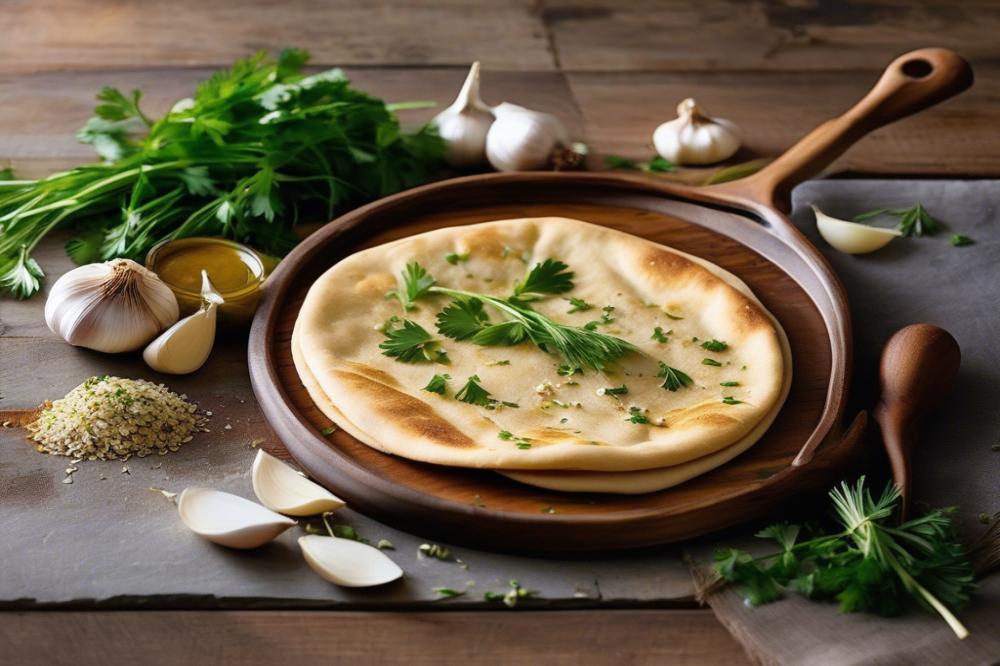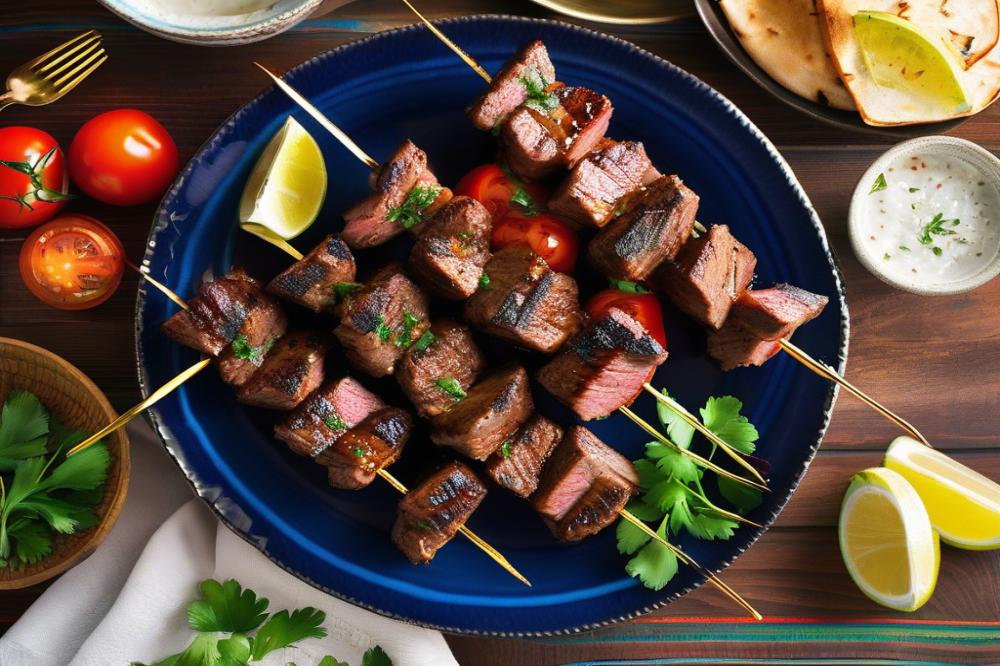Introduction
Lebanese cuisine is a vibrant tapestry of flavors, colors, and traditions that reflects the rich history of the region. It holds significant importance in the Middle Eastern culinary scene, celebrated for its diversity and freshness. Dishes often include a blend of spices, herbs, and seasonal ingredients, creating a delightful experience for any food lover. Each meal becomes a gathering of family and friends, reinforcing bonds over shared plates.
At the heart of many Lebanese meals, flatbreads play an essential role. These traditional breads serve not only as a side dish but also as a means to scoop up flavorful dips like hummus or baba ghanoush. The flatbreads have evolved in countless ways, adapting to the tastes and preferences of different cultures while retaining their classic charm. Among these, a garlic flatbread stands out for its irresistible aroma and taste.
The garlic and herb flatbread holds a special place in this culinary world. It blends Mediterranean flavors with the warmth of freshly baked artisanal bread. This easy flatbread recipe is perfect for both novice cooks and seasoned bakers. Mixing fresh herbs with robust garlic creates an irresistible combination that elevates the simplest of meals. Baking tips, like achieving the perfect crispiness, are essential to mastering this dish. Embracing the warmth of homemade flatbread is an experience everyone should savor.
Lebanese flatbread
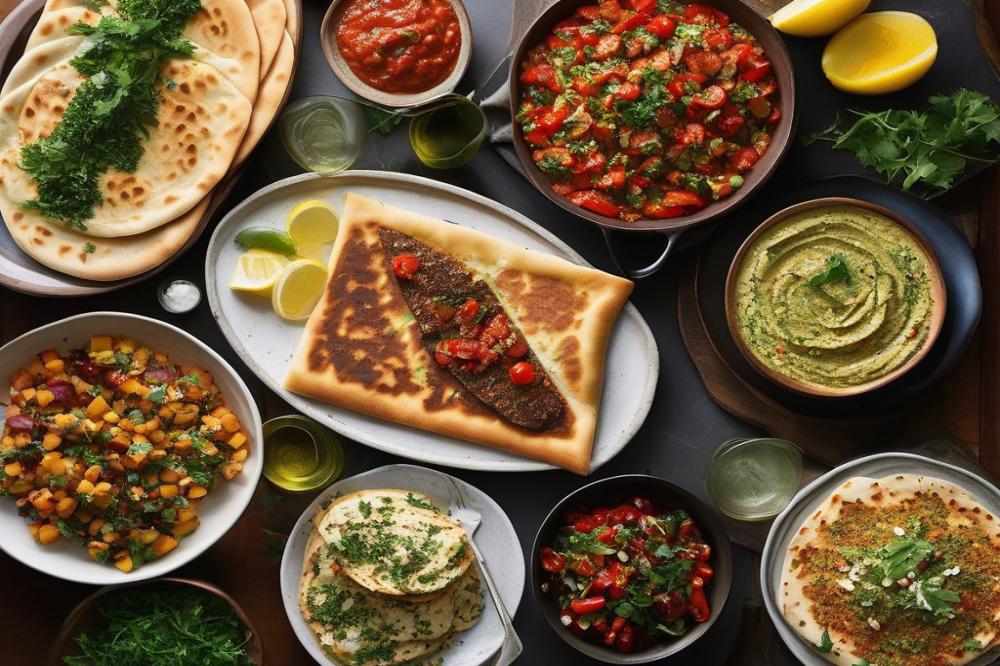
Lebanese flatbread is a staple in many Middle Eastern diets. This type of bread is thin and soft, often made from simple ingredients. It can be used to wrap around various fillings or served alongside meals. Its texture is chewy, making it perfect for dipping into sauces or scooping up dips. A flatbread recipe can vary, but the common elements are flour, water, and salt.
Flatbreads from other regions, like naan or tortillas, have different features. Naan, for example, is traditionally leavened and often baked in a clay oven. In contrast, Lebanese varieties are usually unleavened. This distinction highlights the diverse approaches to flatbread in global cuisine. Each type offers distinct tastes and uses, enriching the culinary landscape.
This bread plays a significant role in Lebanese cuisine. Often, it accompanies grilled meats, stews, and meze. When enjoying a meal, garlic flatbread infused with herbs adds a delightful touch. People gather around the table, sharing dishes with this bread as a common element. It fosters a sense of community, inviting togetherness with every bite.
Across the region, variations of this flatbread exist. In some areas, bakers craft artisanal bread with unique twists. Certain recipes might include additional spices or herbs, giving them a special flavor profile. Baking tips for making homemade flatbread often involve precise measurements and kneading techniques. These methods help achieve the desired texture and taste, resulting in a delightful Mediterranean experience.
Ingredients and Quantities
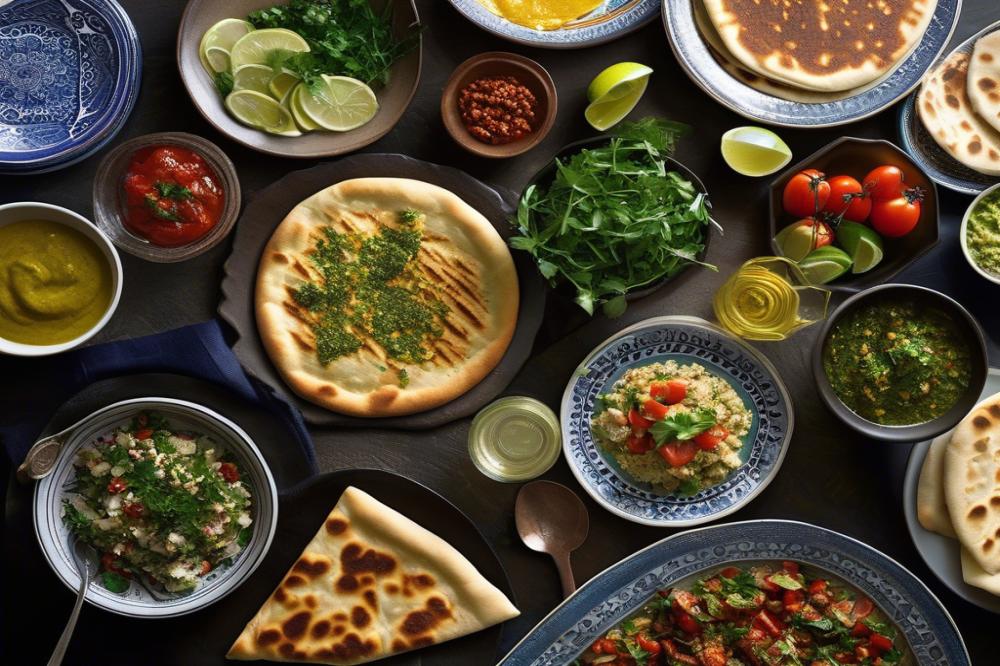
Creating the perfect garlic and herb flatbread requires a selection of fresh ingredients. Here’s what you will need:
- 2 cups all-purpose flour
- 1 teaspoon salt
- 1 tablespoon dry yeast
- 1 teaspoon sugar
- 3/4 cup warm water
- 2 tablespoons olive oil
- 4 cloves of garlic, minced
- 1/4 cup fresh parsley, chopped
- 1/4 cup fresh cilantro, chopped
- 1 tablespoon dried oregano
These quantities create a simple flatbread recipe. Each ingredient plays a vital role in the overall flavors. The flour provides the base, while salt enhances taste. Yeast helps in rising, making the texture light and fluffy. Sugar feeds the yeast, allowing it to work properly. Warm water activates the yeast, while olive oil adds richness. Minced garlic infuses the bread with flavor. Fresh herbs contribute vibrant Mediterranean flavors that elevate the dish. Dried oregano adds a hint of spice, completing the mix.
Nutritional Information
The nutrition of this delightful bread is important to consider. A typical serving provides around:
- Calories: 150
- Protein: 3 grams
- Carbohydrates: 30 grams
- Fat: 4 grams
- Sodium: 300 milligrams
These values can vary based on ingredient brand and specific quantities used. This bread is a practical choice, low in calories while still providing flavor. It suits a variety of diets when eaten in moderation.
Benefits of Using Fresh Herbs and Garlic
Fresh herbs bring vibrancy to the recipe. Parsley and cilantro not only provide flavor but also offer health benefits. They are rich in vitamins and antioxidants. Garlic has long been valued for its medicinal properties. It may boost the immune system and provide anti-inflammatory effects.
Using fresh ingredients in your homemade flatbread enhances its appeal. They contribute to a unique taste and aroma that dried alternatives simply can’t match. Baking with them allows one to experience authentic Lebanese cuisine. This easy flatbread recipe makes a wonderful addition to any meal, showcasing Middle Eastern bread traditions.
When preparing your flatbread, consider these baking tips: knead the dough well for good structure, let it rise in a warm place, and don’t rush the cooking process. These details combined will yield artisanal bread with a delicious crust and chewy texture.
Easy Flatbread Recipe: Cooking Instructions
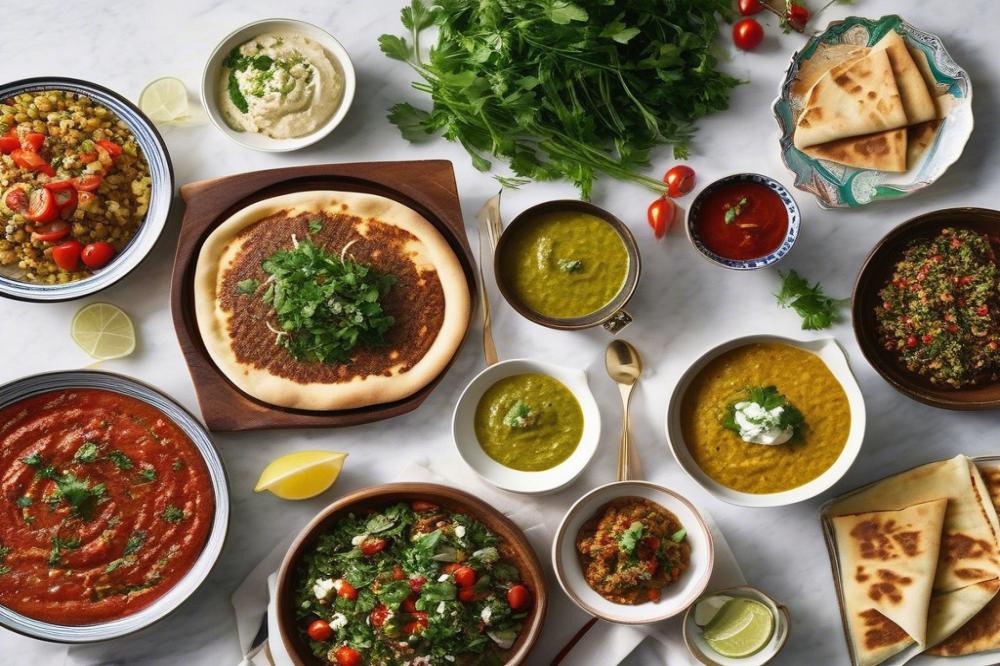
Making homemade flatbread is a rewarding experience. Follow these step-by-step instructions to create a delicious garlic flatbread that highlights the essence of Lebanese cuisine.
Step 1: Prepare the Dough
Start by mixing flour, salt, and a packet of dry yeast in a large bowl. Pour in warm water and a splash of olive oil. Stir the mixture until it forms a sticky dough. Use your hands to knead the dough for about seven to ten minutes. The dough should become smooth and elastic. Rubbing a bit of oil on your hands can make this process easier.
Step 2: Resting Time
Once kneaded, place the dough in a bowl that is lightly oiled. Cover it with a clean kitchen towel. Let it rest for at least an hour. This resting stage allows the yeast to work, making the dough rise. Wider variations in taste and texture can occur depending on how long you let the dough sit. A longer rise gives better flavor.
Step 3: Shaping the Flatbread
After resting, punch the dough down gently to remove excess air. Divide it into equal portions, depending on the size of the flatbread you desire. Roll each piece into a ball and then flatten it with a rolling pin. Aim for a thickness of about a quarter-inch. Using flour on your work surface helps prevent sticking.
Baking Tips
Now, let’s talk about baking methods. You can bake your flatbreads in the oven or on a skillet. A hot oven works great for achieving a nice, puffed flatbread. Preheat your oven to 475°F (245°C). Use a baking stone if you have one. Alternatively, a skillet over medium-high heat produces a lovely crispy texture. Cook each flatbread for about 2-3 minutes on each side.
Tips for Perfecting Flavor and Texture
Incorporating fresh herbs in your dough can add Mediterranean flavors. Rosemary or thyme work especially well. Experiment with minced garlic or garlic powder to enhance the garlic flatbread aspect. Using whole wheat flour can change the texture too, making it more artisanal. Always keep an eye on the flatbreads while baking; they can burn quickly.
Final Touches and Serving
After baking, brush the warm flatbread with olive oil and sprinkle salt on top. This adds a nice finishing touch. Serve it warm with dips like hummus or tzatziki for a complete Middle Eastern experience. The combination of garlic and fresh herbs will make your homemade flatbread unforgettable.
Baking Tips for Artisanal Bread
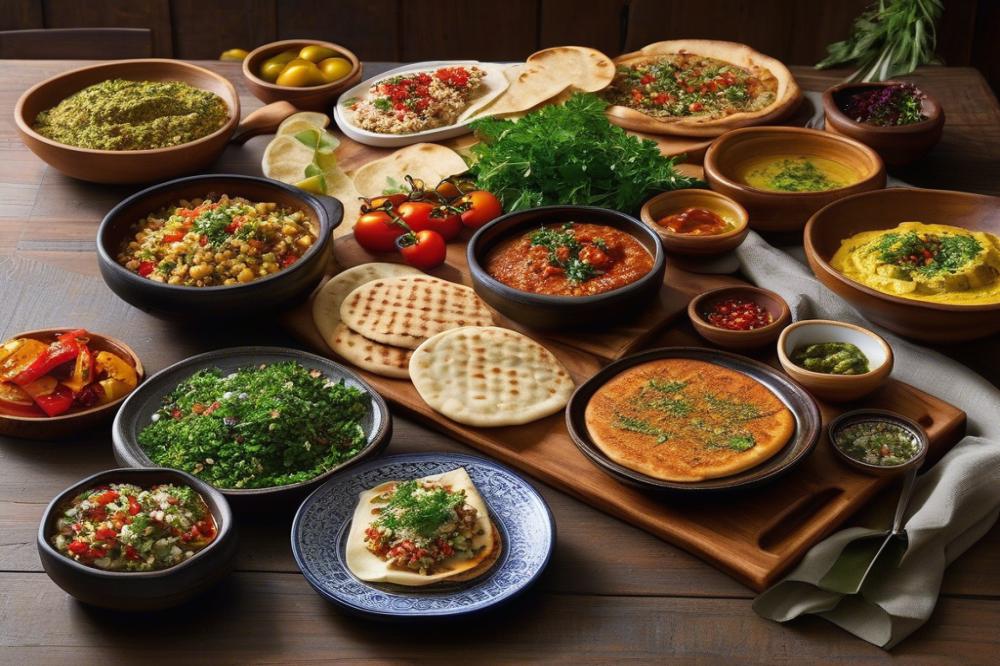
Creating the perfect flatbread requires attention to detail. Start by achieving a crusty exterior while maintaining a soft interior. Use a baking stone or a cast-iron skillet. These tools help distribute heat evenly. Preheat your oven to a high temperature, typically around 475°F (245°C). This intense heat helps in forming a crunchy crust.
Next, consider the texture of your dough. Kneading plays an important role in gluten development. Aim for a smooth and elastic consistency. Add a little water if your dough feels too dry. However, too much moisture can lead to sticky bread. Striking the right balance is crucial.
While preparing the flatbread, common mistakes can hinder success. Avoid using cold ingredients directly from the fridge. Instead, allow them to come to room temperature. This small step can significantly improve the dough’s rise. If rolling out your dough, ensure it isn’t too thin. An overly thin flatbread lacks the desired chewiness that complements Mediterranean flavors.
Storage is equally important for homemade flatbread. Keep it in an airtight bag or container at room temperature. This helps maintain its softness. If you’re planning to enjoy it later, refrigerate but remember to wrap it well. For reheating, a quick bake in the oven will revitalize the bread. Heat at 350°F (175°C) for about five minutes. This method brings back the delightful texture and flavor.
By following these baking tips, your journey into Lebanese cuisine can bloom. Making an easy flatbread recipe at home can be rewarding. Enjoy the process and the wonderful aromas that fill your kitchen!
Serving Suggestions
Ideas for pairing garlic and herb flatbread with Lebanese dishes
Garlic flatbread complements many dishes from Lebanese cuisine. It works wonderfully alongside hummus, adding a delightful crunch and flavor. Consider serving it with tabbouleh for a fresh, herbaceous mix. Skewers of grilled chicken or beef can also be paired perfectly. The flatbread can help balance the spices and richness of the meat. For a more substantial meal, try it with shawarma. The aromatic spices in the shawarma make a great match with the flatbread. Each bite brings a burst of deliciousness, enhancing your dining experience.
Incorporating Mediterranean flavors into meals
Mediterranean flavors shine when adding homemade flatbread to your table. Think about using it to scoop up baba ghanoush or tzatziki. These dips are rich in taste and creamy in texture. You can also layer flatbread with roasted vegetables for a colorful dish. Drizzling olive oil and sprinkling feta cheese adds even more flavor. This brings a rich contrast to each bite. Bringing together these elements creates a feast of tastes and aromas. Fresh herbs such as mint or parsley can elevate the dish further. Their bright notes will make your meal memorable.
Creative ways to use leftover flatbread
Leftover flatbread doesn’t have to go to waste. Transform it into croutons for salads, adding a crispy element. Simply toast the pieces with olive oil and seasoning for extra flavor. Another option is to create mini pizzas. Spread some tomato sauce and top with cheese and your favorite toppings. Bake until golden and bubbly. This easy flatbread recipe brings joy to your kitchen while minimizing waste. You can even slice it into strips and serve it as a snack with dips. The possibilities are endless, and your taste buds will appreciate the creativity.
The Heart of Sharing: Garlic and Herb Flatbread
Garlic and herb flatbread holds a special place in Lebanese cuisine. It is not just food; it embodies tradition, family, and warmth. As a staple, it pairs excellently with various dishes, adding flavor and delight to any meal. The aromas of garlic and fresh herbs can make a kitchen feel inviting and cozy. It represents gatherings with loved ones, turning meals into cherished memories.
Making homemade flatbread is a rewarding experience. A simple flatbread recipe provides a chance to connect with your cooking roots and discover the joys of kneading dough and watching it rise. With some practice, perfecting this recipe can lead to delicious results worth sharing. The satisfaction of pulling warm, herb-infused bread out of the oven is truly unmatched.
Baking these delightful breads should be a joyful endeavor. It encourages creativity in the kitchen, allowing you to experiment with various ingredients like spices or oils. Sharing this fresh-baked goodness with friends and family can encourage lively conversations and happy faces around the table. In every bite, there’s a piece of culture, love, and community that makes Lebanese food so special.

